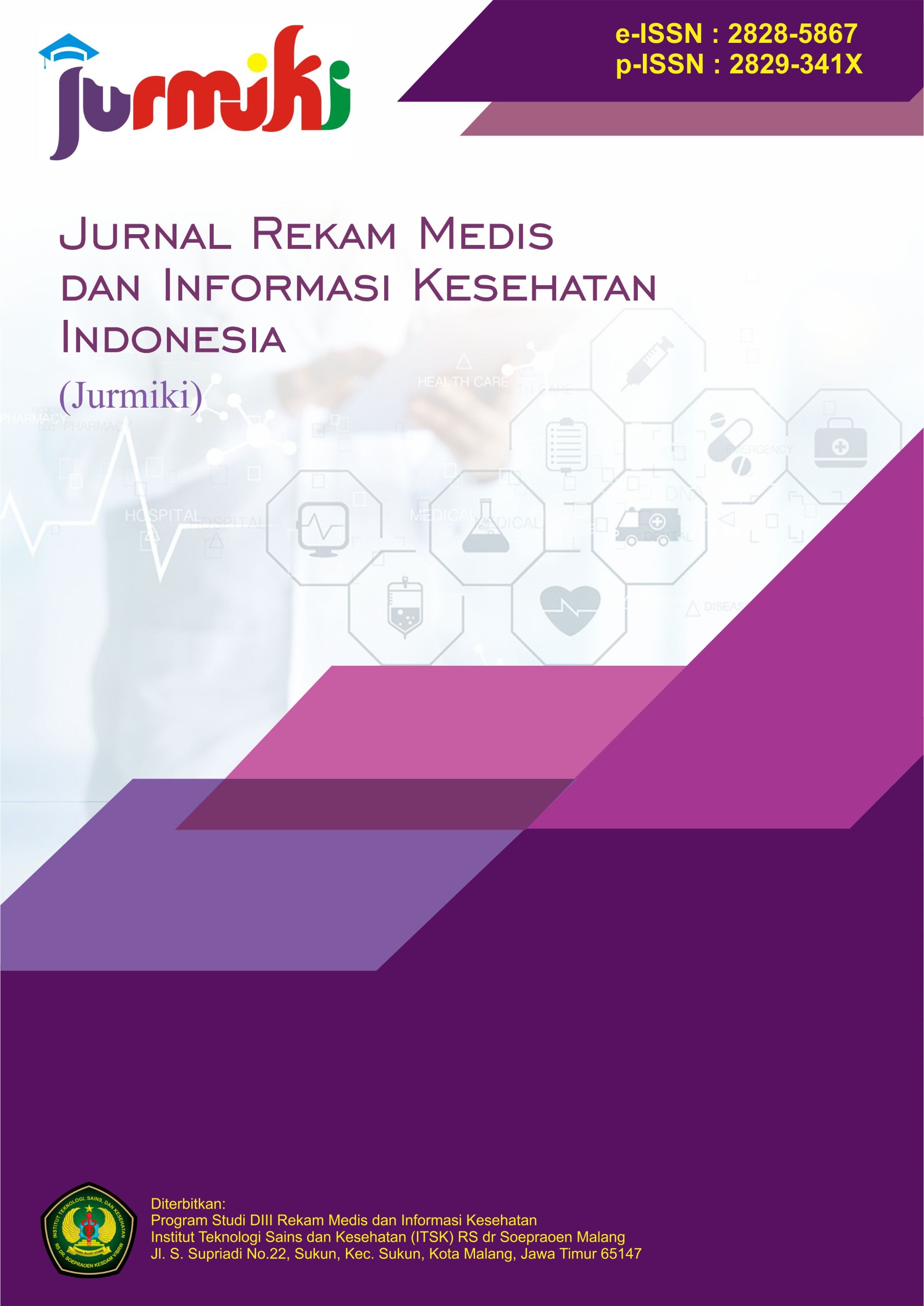Readiness of Electronic Medical Record Implementation at Budi Asih Trenggalek Hospital using the Fishbone Diagram Method
DOI:
https://doi.org/10.62951/jurmiki.v4i2.96Keywords:
Medical RecordsAbstract
The electronic medical record (EMR) is an important step in supporting the digitization of health services, with the aim of improving the effectiveness, efficiency and accuracy of the management of patient medical data in hospitals. This study aims to determine the readiness of the implementation of RME in BUDIASIH Hospital Trenggalek by using the Fishbone Diagram method as an analytical tool in identifying the factors that influence.This study uses a descriptive method with a qualitative approach to explore the implementation process in depth. The Data was obtained through in-depth interviews and direct observation to 20 informants who actively use the RME system in the implementation of daily tasks.The results showed that the readiness of RME implementation in Budi Asih Hospital was influenced by five main factors, namely man (Human Resources), matherial (tools), machine (data), method (methods), and money (budget). Health workers and administrative staff have been able to operate RME well, accompanied by regular training and workshops to improve understanding related to System updates. Equipment and support systems are available and functioning properly, along with scheduled maintenance to keep the system running stably. Data management has been done accurately and timely, supported by periodic audits to maintain the quality and validity of the data. The hospital also has a clear Standard Operating Procedure (SOP) I n the implementation of RME and has allocated a budget to support the sustainability of this system. Overall, Budi Asih Trenggalek Hospital has shown good readiness in the implementation of RME and is ready to develop this system to support the improvement of the quality of health services in the future.This study recommends increased maintenance of software and hardware as well as regular training of human resources to support the sustainability of the RME system.
References
Amatayakul, M. (2017). Electronic health records: A practical guide for professionals and organizations. CRC Press.
Aviat. (2023). Challenges of electronic medical record system implementation in Indonesia. Retrieved from https://aviat.id
Department of Health Republic of Indonesia. (2006). Guidebook for the implementation of hospital medical records (p. 13). Health Journal.
Fakhruddin, A., & Prabowo, H. (2019). Security and privacy of electronic medical record data in hospitals. Journal of Health Information Technology, 13(2), 45–52.
Handiwidjojo, W. (2009). Medical record management (2nd ed.). Jakarta: EGC Medical Book Publisher.
Hidayati, N. (2021). Electronic medical record management in hospitals: A review of data security aspects. Journal of Health Administration, 9(2), 156–164.
Ishikawa, K. (1985). What is total quality control? The Japanese way. Prentice Hall.
Kurniawan, A., & Wulandari, S. (2022). Literature review: An overview of electronic medical record implementation in Indonesian hospitals. Journal of Hospital Management, 5(4), 120–130. https://e-journal.unair.ac.id/MGK/article/download/54343/29222
Kurniawati, N. (2021). Effectiveness of electronic medical record system implementation in hospitals. Journal of Health Sciences, 15(3), 234–240.
Ministry of Communication and Information. (2023). Collaboration with Ministry of Health, Kominfo encourages RME utilization in East Java. Retrieved from https://aptika.kominfo.go.id/2023/04/kolaborasi-dengan-kemenkes-kominfo-encourage-rme-utilization-in-east-java/
Ministry of Health of the Republic of Indonesia. (2022). Regulation of the Minister of Health of the Republic of Indonesia No. 24 Year 2022 concerning medical records. Retrieved from https://yankes.kemkes.go.id/view_artikel/2714/rekam-medical-electronic-purpose-and-benefits
Mulyani, N., & Yuliana, S. (2022). The role of electronic medical records in improving coordination between health facilities. Journal of Health Management, 20(4), 123–130.
Nugroho, A. (2022). Implementation methods of electronic medical records in hospitals: A case study at Hospital X. Journal of Health Technology, 4(1), 45–51.
Pamuji, A., Igiany, P. D., & Andriani, R. (2024). Systematic literature review: Factors influencing the implementation of electronic medical records. Prepotive Journal, 8(1).
Permenkes No. 56 Tahun 2014 tentang Klasifikasi dan Perizinan Rumah Sakit. (2014).
Pratama, D. (2021). Cost of electronic medical record implementation in hospitals: Challenges and solutions. Journal of Health Economics, 10(3), 120–125.
Risnawati, & Purwaningsih, E. (2024). Analysis of obstacles in the implementation of electronic medical records at the Karang Asam Samarinda Health Center. Nusantara Journal of Community Service, 5(2).
Salsabila, R., & Pujilestari, I. (2024). Analysis of obstacles in the implementation of electronic medical records in the outpatient unit using the fishbone method at Bandung Kiwari Hospital. Tambusai Health Journal, 5(3).
Santriawati, R., & Ulfah, A. (2024). Analysis of electronic medical record implementation on the quality of outpatient services. Journal of Health and Medical Technology, 8(6).
Sari, D. K., & Winarno, A. (2024). Analysis of electronic medical record implementation at Radjak Purwakarta Hospital. Indonesian Health Records Media, 3(1).
Sari, M., & Jannah, I. (2020). The effect of technology infrastructure on the effectiveness of electronic medical records in hospitals. Journal of Health Technology and Management, 8(1), 75–82.
Sari, R., & Handayani, T. (2020). Reduction of medical errors through the use of electronic medical records. Indonesian Journal of Medicine, 68(2), 78–85.
Siahaan, P., & Siregar, R. (2021). The role of human resources in the successful implementation of electronic medical records in hospitals. Journal of Public Health, 7(4), 134–141.
Stikes Borneo Husada. (2024). Get to know medical record coding and its benefits. Retrieved from https://stikeshb.ac.id/mengenal-coding-rekam-medis-dan-manfaatnya/
Sukmawati, L. (2021). Health data management using electronic medical record system. Journal of Health Informatics, 14(1), 112–118.
Undang-Undang Republik Indonesia Nomor 17 Tahun 2023 tentang Kesehatan. (2023).
Undang-Undang Republik Indonesia Nomor 44 Tahun 2009 tentang Rumah Sakit. (2009).
Watson, G. H. (2004). Six Sigma for business leaders: A guide to implementation. GOAL/QPC.
Downloads
Published
Issue
Section
License
Copyright (c) 2025 Jurnal Rekam Medis dan Informasi Kesehatan Indonesia

This work is licensed under a Creative Commons Attribution-ShareAlike 4.0 International License.








